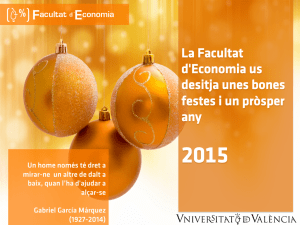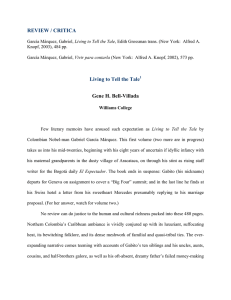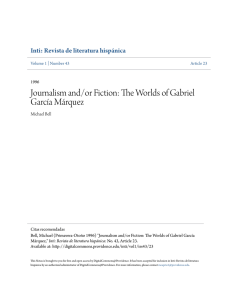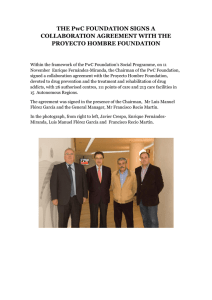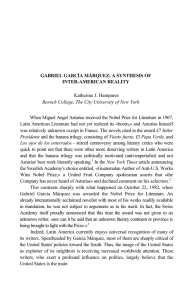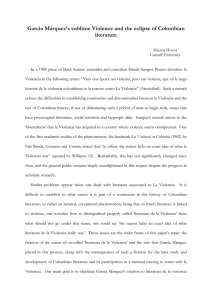Gabriel García Márquez
Anuncio
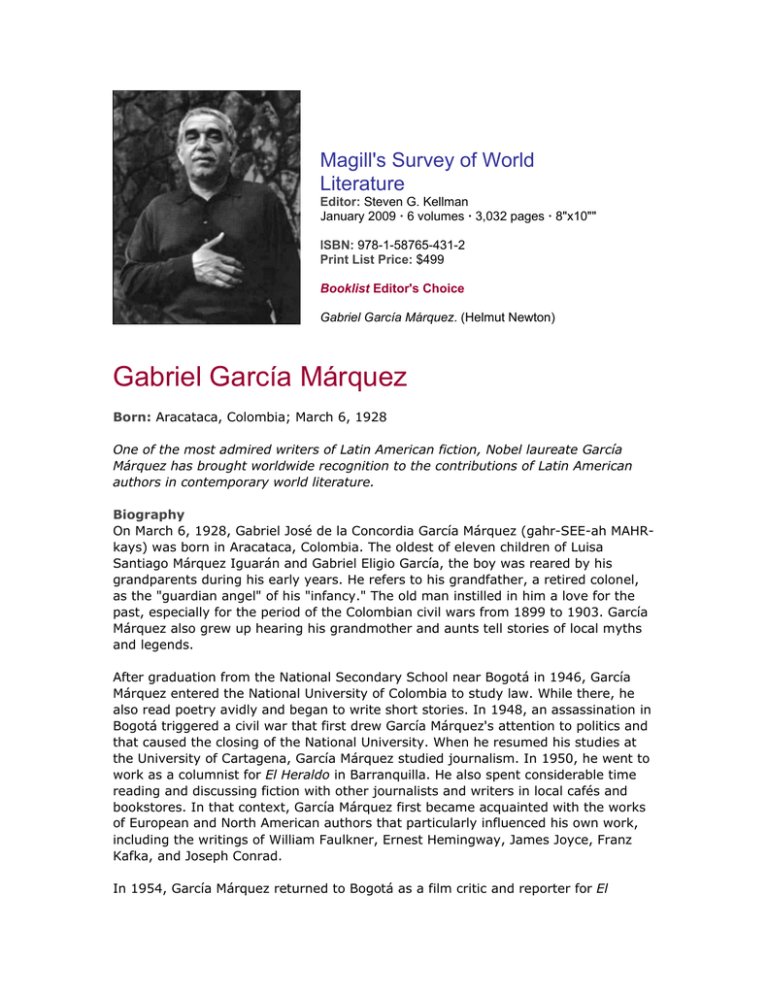
Magill's Survey of World Literature Editor: Steven G. Kellman January 2009 · 6 volumes · 3,032 pages · 8"x10"" ISBN: 978-1-58765-431-2 Print List Price: $499 Booklist Editor's Choice Gabriel García Márquez. (Helmut Newton) Gabriel García Márquez Born: Aracataca, Colombia; March 6, 1928 One of the most admired writers of Latin American fiction, Nobel laureate García Márquez has brought worldwide recognition to the contributions of Latin American authors in contemporary world literature. Biography On March 6, 1928, Gabriel José de la Concordia García Márquez (gahr-SEE-ah MAHRkays) was born in Aracataca, Colombia. The oldest of eleven children of Luisa Santiago Márquez Iguarán and Gabriel Eligio García, the boy was reared by his grandparents during his early years. He refers to his grandfather, a retired colonel, as the "guardian angel" of his "infancy." The old man instilled in him a love for the past, especially for the period of the Colombian civil wars from 1899 to 1903. García Márquez also grew up hearing his grandmother and aunts tell stories of local myths and legends. After graduation from the National Secondary School near Bogotá in 1946, García Márquez entered the National University of Colombia to study law. While there, he also read poetry avidly and began to write short stories. In 1948, an assassination in Bogotá triggered a civil war that first drew García Márquez's attention to politics and that caused the closing of the National University. When he resumed his studies at the University of Cartagena, García Márquez studied journalism. In 1950, he went to work as a columnist for El Heraldo in Barranquilla. He also spent considerable time reading and discussing fiction with other journalists and writers in local cafés and bookstores. In that context, García Márquez first became acquainted with the works of European and North American authors that particularly influenced his own work, including the writings of William Faulkner, Ernest Hemingway, James Joyce, Franz Kafka, and Joseph Conrad. In 1954, García Márquez returned to Bogotá as a film critic and reporter for El Espectador and, in his spare time, composed short stories. He published the first major work, La hojarasca (Leaf Storm, 1972) in 1955. In addition to fiction, García Márquez also wrote a true account of the shipwreck of a Colombian naval destroyer, which El Espectador published anonymously. This story included material about illegal government activity and stirred so much controversy that the editor of El Espectador sent García Márquez abroad to work as a foreign correspondent. When the Colombian government eventually shut down El Espectador altogether, García Márquez remained in Paris. The two political novels that he wrote during this time were well received in literary circles: La mala hora (1962; revised, 1966; In Evil Hour, 1979) and El coronel no tiene quien le escriba (1961; No One Writes to the Colonel, 1968). His fiction did not receive widespread critical acclaim until the publication of his surprise bestseller, Cien años de soledad (1967; One Hundred Years of Solitude, 1970). In 1958, García Márquez left Europe to work for the newspaper Momento in Caracas, Venezuela. That same year, he married Mercedes Barcha and resumed work on his short stories. From 1959 to 1965, however, García Márquez--who, like most Latin American intellectuals, supported the Cuban Revolution--concentrated fully on journalism and political issues. His return to fiction resulted in One Hundred Years of Solitude, a novel that has risen to the foreground of twentieth century fiction. Because of the financial security that it brought, García Márquez was able to support his wife and two sons and still devote himself full time to writing fiction. He also began to travel widely, denouncing political dictatorship and speaking in support of human rights. In 1985, García Márquez published El amor en los tiempos del cólera (Love in the Time of Cholera, 1988), another major work of fiction that received laudatory reviews. A subsequent novel, El general en su laberinto (1989; The General in His Labyrinth, 1990), challenged the image of Simón Bolívar--generally considered to be Latin America's greatest hero--and sparked great controversy in Latin America. He subsequently published several additional collections of short stories, including Doce cuentos peregrinos (1992; Strange Pilgrims: Twelve Stories, 1993); a novel, Memoria de mis putas tristes (2004;Memories of My Melancholy Whores, 2005); and several works of nonfiction, including Noticia de un secuestro (1996; News of a Kidnapping, 1997) and the first volume of his projected three-volume memoir, Vivir para contarla (2002;Living to Tell the Tale, 2003). His latter books show an increasing attention to political and social concerns, a marked change from his earlier works and their tendency toward Magical Realism and the fantastical. Nevertheless, most of his works retain their air of the imaginative and continue to demonstrate his highly artistic style. In 1971, García Márquez received an honorary doctorate from Columbia University, and in 1972 he won the prestigious Rómulo Gallegos Prize in Venezuela and the Neustadt International Prize for Literature; he was awarded the Nobel Prize in Literature in 1982. Returning to Colombia in 1990 after living abroad for thirty years, García Márquez continued to commute with his wife among homes in Mexico, Cuba, and Colombia. In 1999, García Márquez was diagnosed with lymphatic cancer, an event that induced him to finally begin work on his memoirs. La Republica, a Peruvian daily newspaper, incorrectly reported his imminent death in 2000.
